Mercedes 107 SLC coupé 1971 – 1981


Type 350 SLC, presented at the Paris Motor Show in October 1971, became the successor of the coupé models 280 SE and 280 SE 3.5.

They had not been produced any more since June and August 1971 respectively. In February 1972, four months after the premiere, the series production of the newcomer – internally called C 107 – began.

In contrast to its predecessors, the new coupé was not based on a limousine of the upper class, but rather was a sister model of the 350 SL, presented six months ago.

Except for the hard roof of the SLC, both variants were identical up to the door rear edge. The differences showed themselves in the rear half of the car.

The wheelbase, prolonged by 360 mm in comparison to the SL, allowed a larger interior and four full-sized seats.
The many construction details – used for the first time in the 350 SL for safety reasons – were now, as a matter of course, transferred without any restrictions to the coupé-variant.

Thus the fuel tank of the 350 SLC was not located in the rear end any more, but above the rear axle. Inside a strongly padded dashboard, deformable or concealing switches and controls, as well as the new four-spoke security wheel with impact absorber and broad impact cushion provided for utmost crash protection.

Newly developed cowl panels at the A-pillars, serving as water-shield gutters, guarantee good visibility in rain and keep the side windows clean in bad weather.
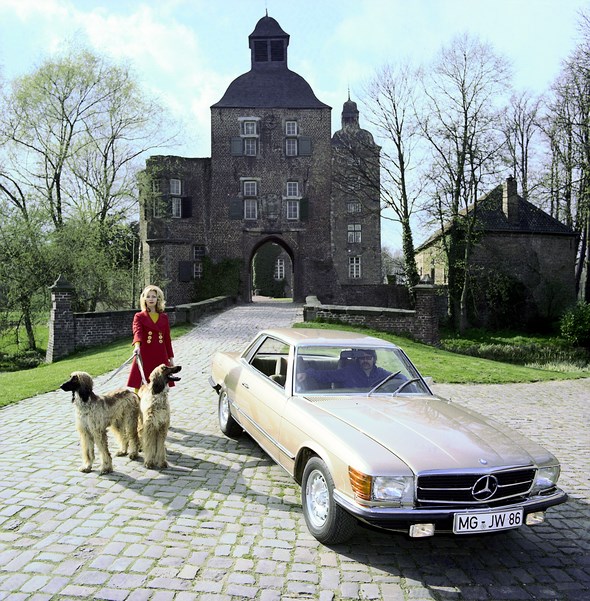
Further security details were the wide wraparound direction indicators, well visible also from the side, as well as the broad rear lamps. Thanks to their ribbed surface profile they are very insusceptible to dirt.
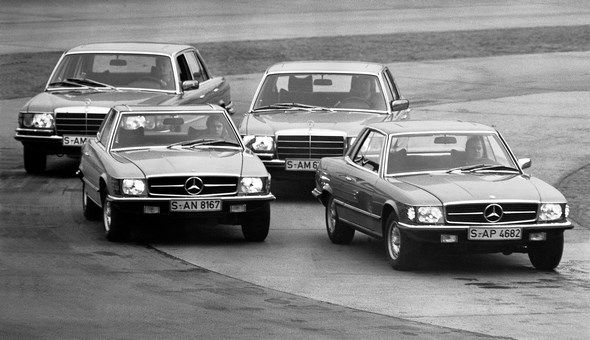
From April 1973 onwards, the SLC coupé as well as the SL were also available with a larger displacement, with a 4.5-liter V8-engine performing 225 hp.

Another version of this engine – adapted to the US-American exhaust-emission regulations – with less compression and 195 hp had already been available as a North-American model since 1972.

In July 1974 the 107 series type range was once more enlarged. As a consequence of the oil crisis in the year 1973, roadster and SLC were now also offered with the 2.8-liter dohc fuel-injection engine.
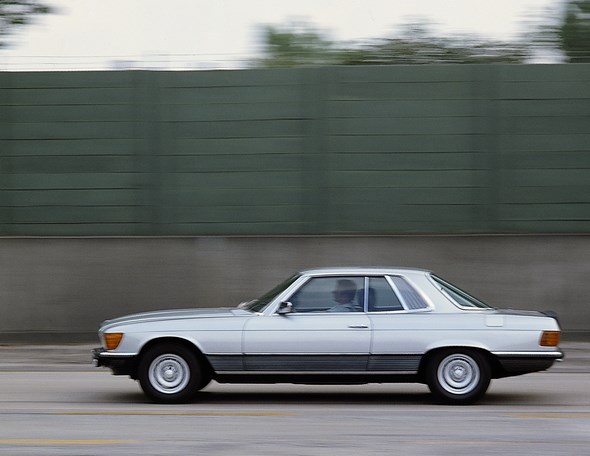
It had already stood its test in the “dash-eight” series as well as the S-class for two years. Thus, three SLC coupés, each with a different engine, were available.

Only an attentive observer was able to differentiate between the three versions. The 280 SLC could be recognised by its narrow tires.

Type 450 SLC was characterised by an inconspicous front spoiler applied at the rear low end of the front apron and thus increasing the rate of air flow considerably.

Between November 1975 and February 1976 the fuel injection system of all three engines was modified in order to correspond to the now stricter exhaust-emission standards in most European countries.

The electronically controlled Bosch “D-Jetronic” was replaced by the newly developed mechanically controlled Bosch “K-Jetronic”. In all three cases the conversion was connected with slight power reductions.

In the 2.8-liter engine as well as in the 3.5-liter engine the compression was lowered at the same time. In order to facilitate maintenance both V8-engines were equipped with a breakerless transistor ignition and a hydraulic valve-clearance compensation.

In the 2.8-liter aggregate the compression was increased to its former value in April 1978. With the help of some further measures the former power output could be reached again.

At the Frankfurt Motor Show IAA in September 1977 the 450 SLC 5.0, a new top model of the type range 107 was presented.

The great novelty of this type was a 5.0-liter all-aluminium engine, developed from the time-tested 4.5-liter V8 with grey cast iron block. The new engine had an enlarged cubic capacity realised by reboring.
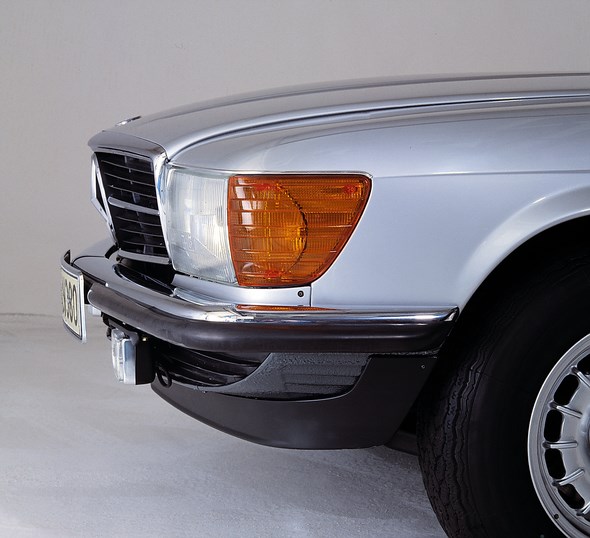
It weighed 40 kg less and convinced by a higher torque and a power increase of 240 hp.

The weight reducing measures were not limited to the engine; the body was also included: engine bonnet, boot-lid and both bumpers were of aluminium.
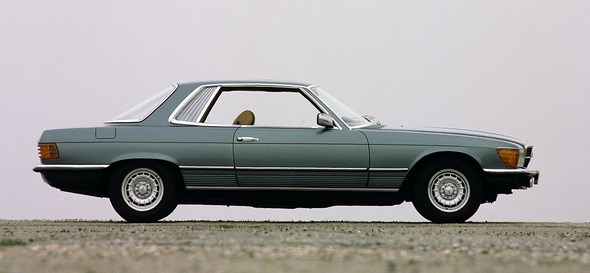
Together with the standard light-alloy rims a further weight reduction of more than 80 kg was achieved. From the outside the 450 SLC 5.0 was recognised by its discreet front spoiler, its black plastic rear spoiler and its uniform grey paint coat under the protective strips at the side.
The main goal, however, in using these add-on parts rather unusual for Daimler-Benz was not an optical improvement. Decisive was the considerably reduced negative lift force at the front and rear axle achieved with the help of both spoilers.

The series production of 450 SLC 5.0 was taken up in May 1978. There was no counterpart in the SL roadster range. Valuable experience was gained in manufacturing the engines which was not always without problems.
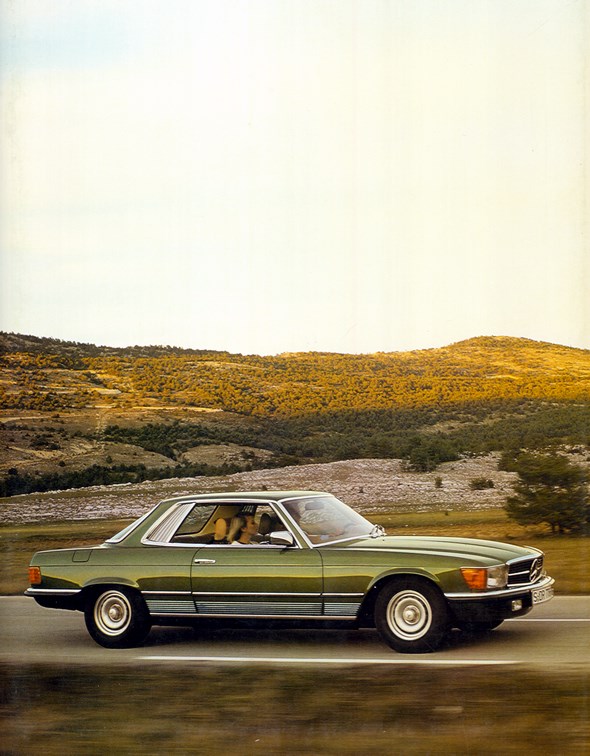
Since the practical testing of the production car by customers did not bring any negative surprises and all the 5-liter coupés were evaluated positively by its drivers nothing prevented the use of all-aluminium engines in the high-volume S-Class range.

Therefore the low-volume model 450 SLC 5.0 functioned as a technological forerunner and pioneer for the large-scale production.
Against the background of imaginable sportive activities with the 5-liter coupé, the displacement capacity of 5,025 cc was not so well chosen with respect to aspects of homologation.
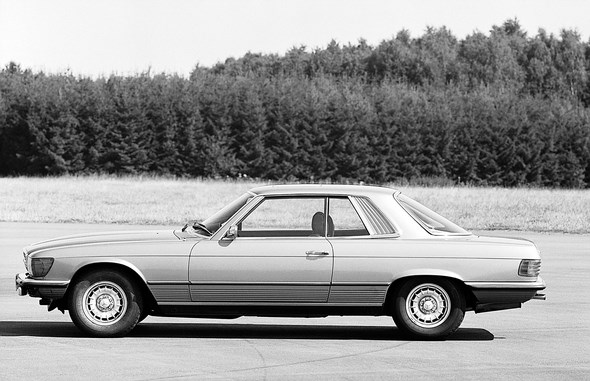
In order not to fall behind, the bore was reduced by 0.5 mm which resulted in a total piston displacement of now 4,973 cc. The modified engine with reduced displacement used in the standard production from May 1979 onwards.
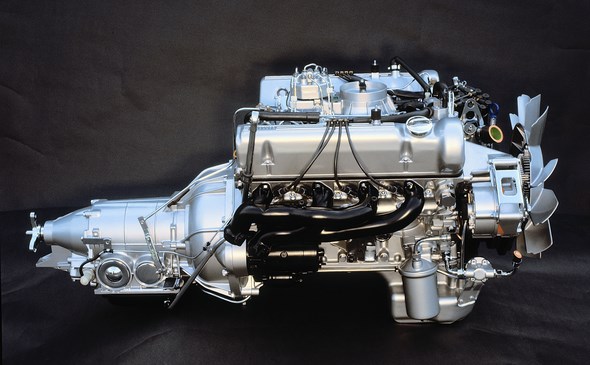
With its potentials of performance and price the 5-liter coupé certainly fulfilled its role as technical speciality and exclusive model. However, regarding the 2,769 cars that were built, we can only talk of a certain exclusivity.
At the Geneva Motor Show in March 1980 the SLC coupés and the roadsters of the type range 107 presented themselves in an updated form.
The interior as well as the steering wheel was adapted to the S-Class saloons. The mechanics, too, was brought up to date. The 3-speed automatic transmission was replaced by a 4-speed version.

The all-aluminium engines of the S-Class were now also used in a slightly modified variant in the 107 series.
The 450 SLC 5.0 was renamed into 500 SLC, thus functioning as successor to the 450 SLC. A lot of exclusivity, however, was lost, since there existed already a 500 SL, a 500 SE and a 500 SEL with the same engine and almost identical driving performance.

The 350 SLC was cancelled in favour of the 380 SLC. Ist 3.8-liter all-aluminium aggregate had been built after the 5-liter from the time-tested 3.5-liter V8 with grey cast iron block.

Only the 6-cylinder engine of the 280 SLC remained unchanged in the program. From the outside, except for the type label, almost no differences to the preceding models could be spotted.
All three SLC types were now equipped with front spoiler known form the 450 SLC 5.0. The black plastic rear spoiler, however, was exclusively used in top models.

18 months after this last big model improvement, the SLC coupés of type range 107 had to yield to their successors. They were based on the S-Class saloons and only available with 8-cylinder engines.
Within a production time of ten years all in all 62,888 cars had been produced.



